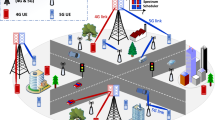Abstract
In this game theoretic proposed work, non-cooperative game is considered in heterogeneous network (Hetnet), and each base station is treated as a competitive player in the game, where all base station compete selfishly to transmit at higher power. The solution of this game theoretic approach is mathematically derived to find out the optimal point through Nash equilibrium (NE). It leads to enhancing the overall performance in terms of throughput, energy efficiency and power consumption, through the vicinity of constraints such as load, small cell density and unnecessary blockage. The reward function is designed to provide each player with the desired transmission power by taking into account their power consumption, base station density and the risk of blockage. For the proposed approach, the existence of the Nash equilibrium is proved, and a next-generation heterogeneous network is suggested with an optimal cost solution.










Similar content being viewed by others
References
Yamuna Devi, M.M., et al.: Reconfigurable intelligent surface aided indoor and outdoor user distribution in heterogeneous network. Int. J. Comput. Netw. Inform. Secur. 14(4), 89–97 (2022). https://doi.org/10.5815/ijcnis.2022.04.07
Jiang, Y., Lu, N., et al.: Energy Efficient Non-Cooperative Power Control in Small Cell Networks. IEEE Trans. Vehicular Technol. 66, 0018–9545 (2016)
Dai, H., Zhang, H., Wu, W., et al.: A game-theoretic learning approach to QoE-driven resource allocation scheme in 5G-enabled IoT. J Wireless Com. Netw. 2019, 55 (2019). https://doi.org/10.1186/s13638-019-1359-7
F. Irrum, M. Ali, M. Naeem, A. Anpalagan, S. Qaisar, and F. Qamar, “D2D-enabled resource management in secrecy-ensured 5G and beyond heterogeneous networks,” Phys. Commun., vol. 45, Apr. 2021, Art. no. 101275. https://www.sciencedirect.com/science/
J. Antoniou, “Game theory and networking,” in Game theory, the internet of things and 5G Networks (EAI Springer Innovations in communications and computing), Cham, Switzerland, 2020.
Pimmy, G., Kumar, R.: Green communication ın next generation cellular networks: a survey. IEEE Access, Digital Object Identifier (2017). https://doi.org/10.1109/Access.2017.2711784
Khodmi, A., Rejeb, S.B., Agoulmine, N., Choukair, Z.: A joint power allocation and user association based on non-cooperative game theory in an heterogeneous ultra-dense network. IEEE Access 7, 111790–111800 (2019)
Haitham Al-Obiedollah et al,”Energy-efficient opportunistic multi-carrier NOMA-based resource allocation for beyond 5G (B5G) networks”,Simulation Modelling Practice and Theory,Volume 116,2022, 102452,ISSN 1569–190X,
Yasar, L.H., Mischa, D., Amr, M., Mokhtar, G.M., Fabiana, C.C.: Towards energy-aware 5G heterogeneous networks, pp. 31–44. Springer, Berlin (2016)
Alhabo, M., Zhang, L., Nawaz, N., Al-Kashoash, H.: A game theoretic handover optimization for dense small cells heterogeneous networks. IET Commun. 13, 2395 (2019)
Azari, A., Stefanovi, C., Popvski, P., Cavadar, C.: Energy-efficient and reliable IoT access without radio resource reservation. IEEE Trans. Green Commun. Netw. 5(2), 908–920 (2021)
Gorla, P., Deshmukh, A., Joshi, S., Chamola, V., Guizani, M.: A game theoretic analysis for power management and cost optimization of Green base stations in 5G and beyond communication networks. IEEE Trans. Netw. Serv. Manage. 19(3), 2714–2725 (2022). https://doi.org/10.1109/TNSM.2022.3149593
Rajee, A.M.: Machine ıntelligence technique for blockage effects in next-generation heterogeneous network. Radioengineering. 29(3), 0555–0562 (2020)
Li, Y., Zhang, H., et al.: Energy-efficient deployment and adaptive sleeping in heterogeneous cellular networks. IEEE Access 7(35), 838–935 (2019)
Munir, H., Hassan, S. A., Pervaiz, H., & Ni, Q. (2016). A game theoretical network-assisted user-centric design for resource allocation in 5G heterogeneous networks. In 2016 IEEE 83rd vehicular technology conference (VTC Spring) (pp. 1---5).
Amin, O., Bedeer, E., Ahmed, M.H., Dobre, O.A.: Energy efficiency-spectral efficiency tradeoff: a multiobjective optimization approach. IEEE Trans. Veh. Technol. 65(4), 1975–1981 (2016)
Author information
Authors and Affiliations
Corresponding author
Additional information
Publisher's Note
Springer Nature remains neutral with regard to jurisdictional claims in published maps and institutional affiliations.
Rights and permissions
Springer Nature or its licensor (e.g. a society or other partner) holds exclusive rights to this article under a publishing agreement with the author(s) or other rightsholder(s); author self-archiving of the accepted manuscript version of this article is solely governed by the terms of such publishing agreement and applicable law.
About this article
Cite this article
Rajee, S.A.M., Merline, A. & Devi, M.M.Y. Game theoretic model for power optimization in next-generation heterogeneous network. SIViP 17, 3721–3729 (2023). https://doi.org/10.1007/s11760-023-02599-8
Received:
Revised:
Accepted:
Published:
Issue Date:
DOI: https://doi.org/10.1007/s11760-023-02599-8




